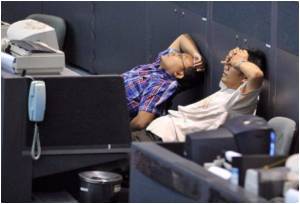People with depression may benefit as much from acupuncture as they do from counseling, suggests a new study.
Researchers found one in three patients were no longer depressed after three months of acupuncture or counseling, compared to one in five who received neither treatment.
“For people who have depression, who have tried various medical options, who are still not getting the benefit they want, they should try acupuncture or counseling as options that are now known to be clinically effective,” said Hugh MacPherson, the study’s lead author from the University of York in the UK.
Previous studies looking at whether acupuncture helps ease depression have been inconclusive. Those studies were also small and didn’t compare acupuncture to other treatment options.
“What’s more important for the patient is does it work in practice and that is the question we were asking,” MacPherson said.
For their study, he and his colleagues recruited 755 people with moderate or severe depression. The researchers split participants into three groups: 302 were randomly assigned to receive 12 weekly acupuncture sessions, another 302 received weekly counseling sessions and 151 received usual care only.
About 70 percent of people had taken antidepressants in the three months before the study and about half reported taking pain medications. People did not have to stop taking their medicine to participate in the study.
At the outset, participants had an average depression score of 16 on a scale from 0 to 27, with higher scores symbolizing more severe depression. A 16 is considered moderately severe depression.
After three months, people assigned to the acupuncture group had an average score of about 9 – on the higher end of the mild depression category. Scores fell to 11 among members of the counseling group and about 13 in the usual care group, both considered moderate depression.
Participants who received acupuncture or counseling saw larger improvements over three months than those who had neither treatment. Those benefits remained for an additional three months after the treatments stopped.
However, any differences between acupuncture and counseling could have been due to chance, the researchers reported Tuesday in PLOS Medicine.
They found doctors would need to treat seven people using acupuncture and 10 people with counseling for one person to no longer be depressed.
“What this says is if you don’t get completely better, there are other options,” Dr. Philip Muskin, a psychiatrist at Columbia University Medical Center in New York, told Reuters Health.
“One option would be to take a different medication, but by this study these would be valid options,” said Muskin, who was not involved with the new research.
He cautioned, however, that counseling and acupuncture are not replacements for medication. The majority of study participants were still taking antidepressants at the end of the three months.
Muskin said the study also doesn’t show what types of patients respond best to acupuncture or counseling.
“What I can’t tell from this study is who’s who. Not everybody got better,” he said.
MacPherson said it’s best to ask patients for their treatment preference.
“If you talk to people, they would almost always have a leaning one way or the other,” he said.
Acupuncture is only covered by health insurance in the UK for chronic pain, MacPherson said. In the U.S., some plans also cover acupuncture for pain or nausea.
According to online information from the Mayo Clinic, the risks of acupuncture are low if people hire competent and certified practitioners. Complications can include soreness, organ injury and infections.
“Cleary acupuncture is a new option,” MacPherson said. “This is the first evidence that acupuncture really helps.”
Source: medindia


 One of the most important parts of having generalized anxiety disorder (GAD) is learning how to cope with the persistent anxiety and some of the physical symptoms. This page can serve as a guide to coping with anxiety that will be frequently updated with new articles and information based on practical tips that work to cutting-edge research findings.
One of the most important parts of having generalized anxiety disorder (GAD) is learning how to cope with the persistent anxiety and some of the physical symptoms. This page can serve as a guide to coping with anxiety that will be frequently updated with new articles and information based on practical tips that work to cutting-edge research findings.

 The U.S. Food and Drug Administration has proposed stronger safety language on labels of long-acting and extended-release opioids in response to an epidemic of overdoses and deaths from the widely used pain medicines.
The U.S. Food and Drug Administration has proposed stronger safety language on labels of long-acting and extended-release opioids in response to an epidemic of overdoses and deaths from the widely used pain medicines.

